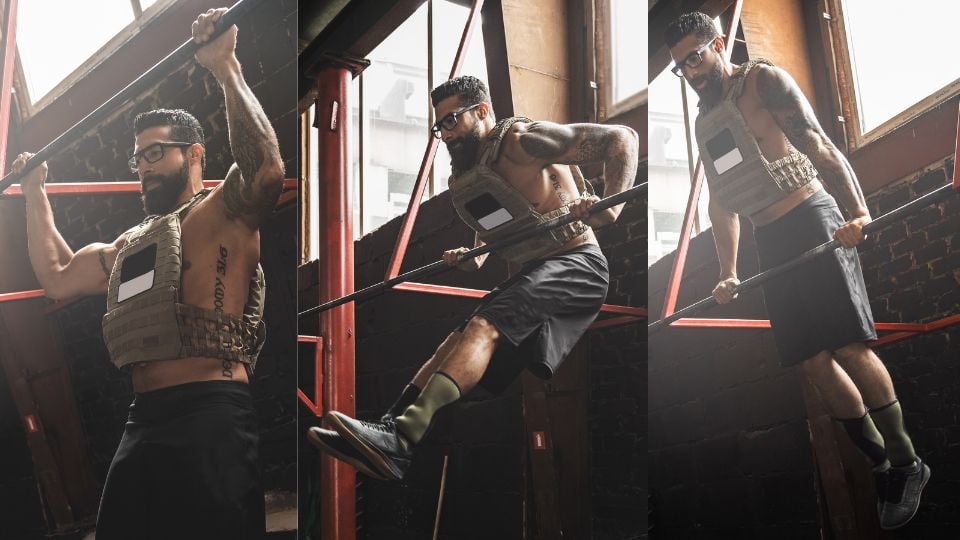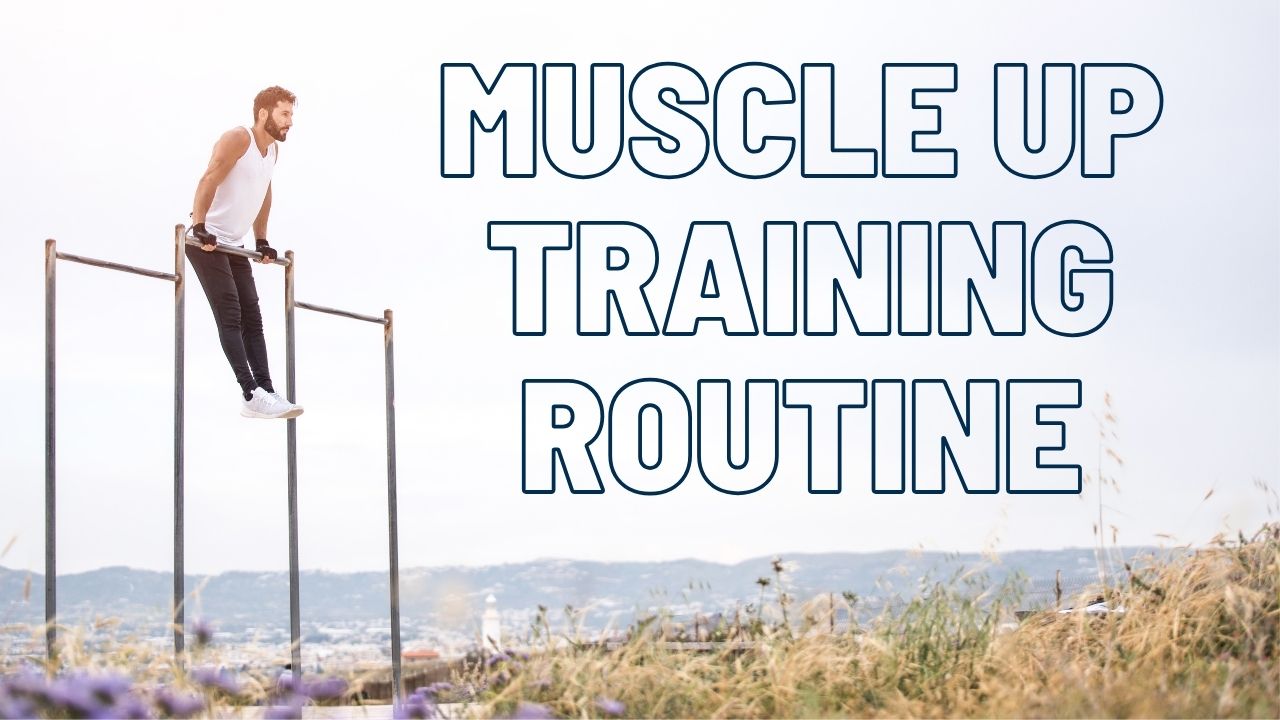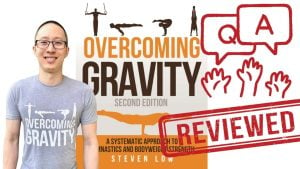The muscle-up is like the superstar of the calisthenics world. It's not just about how strong you are; it's about how well you can get your body to work together. Think of it as a combo move – part pull-up, part dip, but way cooler because it blends raw strength with technique. Mastering the muscle-up is like earning a badge of honor. It’s the end goal that separates the beginners from the advanced athletes, a real milestone in calisthenics. Everyone loves it because it’s tough to master and looks awesome – it’s not just a move, it’s a statement!
Based on my tests I found these wall-mounted pull-up bars to be the best for muscle-ups. The key features are stability and enough distance from the wall and ceiling. If you are based in Europe I can recommend the muscle-up bar from Pullup & Dip (unfortunately the shipping to the US is expensive).
If you want to learn the front lever check out our front lever training routine.

What is a Muscle-Up?
Today, we're going to talk about one of the most iconic moves in calisthenics – the muscle-up. Picture this: you're hanging from a pull-up bar or gymnastic rings. Now, the goal of a muscle-up is to lift your entire body up and over the bar or rings, transitioning from a hanging position to supporting yourself on top with your arms straight. Sounds pretty cool, right?
Let's break it down. The muscle-up is two exercises rolled into one: a pull-up followed by a dip. First, you start with a pull-up. You pull yourself up not just to chin-level but all the way until your chest is at the bar or rings. Then comes the tricky part, the transition. You need to shift your weight forward in a smooth motion, getting your shoulders over your hands. Finally, you straighten your arms as if you're doing a dip. Now, you're on top of the bar or rings, looking like a total boss.
I will talk about them in detail later but in general, there are four main types of muscle ups:
- Bar muscle up
- Ring muscle up
- Strict muscle up
- Kipping muscle up
It's a challenging move, no doubt. It requires not just arm strength but also a good deal of core strength, shoulder stability, and coordination. But don't worry if it sounds a bit intimidating right now. Everyone starts somewhere, and with practice, you'll get there. Work on building up your pull-up strength, your dip strength, and that all-important transition phase. Keep at it, and before you know it, you'll be nailing those muscle-ups!
Muscle-Up Technique
Let's break down the muscle-up into its key components. Understanding these elements is crucial to mastering the move, whether on the bar or the rings. The muscle-up technique consists of five main components that need to work in unison:
- False grip
- Hollow body hold
- High pull-up
- Transition
- Straight bar dip
Grip: For a bar muscle-up, you'll be using an overgrip or false grip. This means your weight will be supported by your wrists rather than wrapping your hand around the bar. In a false grip, you'll grip the rings with your wrists more engaged, almost as if you're hugging the rings. This grip is essential for a smoother transition in ring muscle-ups.
Control and Stability: Throughout the muscle-up, control and stability are key. A stable core is achieved by a vertical hollow body hold. This is where your core strength comes into play. A strong core keeps your movements controlled and efficient.
Pull-Up Phase: The muscle-up starts with a high pull-up. This isn't your regular pull-up; you need to pull yourself up high enough so that your chest touches or comes close to the bar or rings. That means you need serious strength in your back, shoulders, and arms.
Transition Phase: This is the make-or-break part of the muscle-up. It's where you move from the top of the pull-up into the start of the dip. This phase requires not just strength but also technique and timing. You'll need to lean forward and push your shoulders above your hands. It's a quick, fluid motion that takes practice to perfect.
Dip Phase: Once you're above the bar or rings, you'll perform a straight bar or ring dip. This requires good triceps, chest, and shoulder strength to push yourself up until your arms are straight.
So, to nail a muscle-up, you need to work on these components: a secure grip (overgrip or false grip), the strength for a high pull-up, mastering the tricky transition phase, and the power for a solid dip. Each part is crucial, spend time practicing to improve all these aspects.
Ring vs. Bar Muscle-Up
Let's dive into the differences between the ring muscle-up and the bar muscle-up. Both are incredible displays of strength and skill, but they have some key differences that are important to understand.
First up, the ring muscle-up. Many of you will find this version a bit more approachable as your first step into the world of muscle-ups. Why? It mostly comes down to the grip and the rings' movement. When you're using gymnastic rings, you can use what we call a 'false grip' – where your wrist is more over the ring. This grip makes the transition from pull-up to dip a bit more comfortable compared to the bar. Plus, the rings are free-moving, which means you can pull them closer together as you lift yourself. This closer grip at chest level makes the transition phase – that crucial moment when you shift from pulling up to pushing down – smoother and less strenuous.
Now, the bar muscle-up. This one's a bit different. The bar is fixed, so you can't move it closer to ease the transition like you can with rings. You have to go around the bar, which requires more explosive power and a bit more technique during the transition. It's often considered a bit tougher because the false grip is harder to maintain on a bar, and you need more strength and control to maneuver around the bar.
So, for those just starting out, I often recommend beginning with ring muscle-ups. They allow you to get a feel for the muscle-up movement in a slightly more forgiving setup. Once you've mastered the technique and built up the necessary strength on the rings, transitioning to bar muscle-ups will be a challenging but achievable next step.
Kipping vs Strict Muscle-Up
Let's chat about the strict muscle-up versus the dynamic one you often see in CrossFit. The strict muscle-up is like the gold standard in our calisthenics world. It’s all about raw power and control – no fancy tricks, just you and your muscles working in perfect sync. Imagine pulling yourself up on those bars or rings with nothing but pure strength, smoothly transitioning over, and then pushing up. It’s tough, yeah, but it’s the kind of tough that builds real muscle and control. Plus, you're less likely to get injured since you’re not swinging around wildly.
Now, the kipping muscle-up, that’s a whole different ball game. It’s flashy and fast, using momentum to get you over the bar. Think of it as swinging into your move, which lets you do more reps, sure, but it’s more about timing and rhythm than just strength.
It’s cool for what it is, especially in CrossFit, but here in calisthenics, we’re all about that strict movement. Why? Because it really shows off your strength and discipline. It’s not just lifting yourself up; it’s about mastering your body, showing who’s boss. That’s what we aim for – strength, control, and perfect form. It’s tough, but hey, that’s why we do it!
Muscles Worked in a Muscle-Up
Now, let's talk about what's happening under the hood when you're performing a muscle-up. This move isn't just impressive to watch; the muscle-up is a full-body movement that hits a bunch of different muscle groups such as:
- Latissimus dorsi
- Biceps
- Forearms
- Pectorals
- Triceps
- Deltoids
- Abs
- Obliques
- Lower back
First off, your upper body gets a serious workout. During the pull-up phase of the muscle-up, you're primarily using your latissimus dorsi – those are the big muscles on the sides of your back. You're also engaging your biceps and the muscles in your forearms, especially if you're using a false grip.
Then, as you transition to the dip portion of the muscle-up, the focus shifts. Your chest muscles, the pectorals, start to take over, along with your triceps. These muscles help you push your body up and over the bar or rings.
But wait, there's more! Your shoulders, specifically the deltoids, are working hard throughout the entire movement. They provide stability and control, especially during the tricky transition phase.
And let's not forget about the core. Your abs, obliques, and lower back muscles are all engaged to keep your body stable and controlled. A strong core is essential for a smooth muscle-up because it helps you maintain proper form and prevents you from swinging too much.
So, when you're working on your muscle-ups, remember that it's not just an arm exercise. It's a full-body movement that requires strength, coordination, and control from head to toe. Every time you practice muscle-ups, you're giving a whole range of muscles a solid workout. Keep at it, and you'll not only get better at muscle-ups but also build a stronger, more balanced physique.
Muscle-Up Progression
Muscle up isn’t a move you’ll typically nail on day one. It takes progression and building up specific strengths. Luckily, we've got resistance bands, a pull-up bar, and gymnastics rings, which are perfect tools for this. Below are the key exercises that will serve as your progression broken down into subcategories.
What are the prerequisites for the muscle up?
Before we dive headfirst into muscle-ups, let's talk about the prerequisites. These are the building blocks you need to have in place to successfully perform a muscle-up.
Without the required strength your technique will suffer which can lead to injuries. Generally speaking, the main prerequisites that make it likely to achieve a muscle up in proper form are:
- 10 chin to bar pull-ups
- 5 chest to bar pull-ups
- 10 straight bar dips
- 5 ring dips
- false grip hold for 20 seconds
- 30 hollow body swings
First and foremost, foundational strength, especially in your core, is non-negotiable. This isn't just about having six-pack abs; it's about having a strong, stable foundation. A strong core keeps your body aligned and controlled during the muscle-up. It helps prevent unnecessary swinging and provides the stability needed during the transition phase of the muscle-up. So, exercises like planks, leg raises, and hollow holds are going to be your best friends.
Next, and just as crucial, is significant pulling strength. This is the force that gets you from hanging below the bar or rings to getting your chest up and over. Without this, you're not going to get very far in a muscle-up. How do you know if you've got enough pulling strength? A good benchmark is being able to do at least 5 unbroken chest-to-bar pull-ups and 10 strict pull-ups. This means pulling yourself up so that your chest, not just your chin, goes over the bar.
Once you're over the bar or rings, you need the strength to push yourself up. This is where your dip strength comes in. You should be able to do at least 5 straight bar or ring dips unbroken. This shows that you have the pushing strength necessary to complete the muscle-up.
Build up pulling strength
Pulling strength is the number one prerequisite for achieving the muscle up. If you are not able to achieve at least 10 strict pull ups or 5 chest-to-bar pull-ups, make sure to check out our guide to pull up progression for beginners. In addition to the exercises listed there I’d recommend adding the following ones to the list, which are more specific for training for the muscle up.
Chest to Ring or Chest to Bar Holds are all about building the strength you need to pull yourself high enough for the muscle-up. Get into your pull-up position, and pull up until your chest touches the rings or bar. Hold this position for a few seconds. This exercise develops the power in your back and arms necessary for that high pull in the muscle-up.

High pull-ups are a more advanced variation of the standard pull-up and a crucial step towards mastering moves like the muscle-up. In a high pull-up, the goal is to pull yourself up higher than in a regular pull-up. Instead of pulling up just until your chin or neck reaches the bar, you aim to get your chest or even your waist up to the bar level which requires significantly more strength and explosive power. High pull-ups are best practiced on a bar, I’d avoid trying them on rings because of their inherent lack of stability.
Get comfortable with the false grip
False grip is a technique often used in calisthenics and gymnastics to perform advanced exercises by placing the body weight on the inner part of the wrist rather than the palm of the hand.
The false grip is key for ring muscle-ups. You need to master it in order to be able to lift your elbows above your shoulder height. Spend time just hanging from the rings or a bar with a false grip to build up your wrist and forearm strength and get comfortable with this grip.
Band-Assisted Muscle-ups: Use a resistance band on a pull-up bar or rings to practice the full muscle-up movement. The band will take some of your weight, allowing you to focus on the technique, especially the transition. This exercise hits three birds with one stone:
- You will need to use false grip, thus applying what you learned in the previous step.
- By pulling as high as possible your pulling strength will be put to the test.
- The bands will help you pull higher than you would be able to pull without assistance. This gives you a chance to practice the transition phase of the muscle up.
Master the transition
The first exercise I’d like to highlight here is the baby muscle-up. The baby muscle-up is an excellent introductory exercise for those working towards the full muscle-up but who aren't quite ready for the complete movement. This variation is particularly unique because it's performed with your feet on the ground. You start by hanging from a lower pull-up bar or rings, with the bar or rings at a height where your feet can touch the ground while you're hanging.
In this version, you use your feet for support and assistance. As you pull yourself up, you can push off the ground lightly with your feet. This helps you get used to the motion of the muscle-up, especially the challenging transition phase. The idea is to pull yourself up as high as possible, starting the 'roll over' motion that you would do in a full muscle-up, but with the added stability and support from having your feet on the ground.
To increase the difficulty as you get stronger and more confident, you can lower the rings or choose a lower bar. Another way to up the challenge is to use only one foot for assistance, requiring more strength and control from your upper body and core. This gradual progression helps build the necessary strength and technique for the full muscle-up, without jumping straight into the deep end.
The baby muscle-up with feet on the ground is a fantastic way to build towards the full movement. It allows for gradual progression, letting you adjust the difficulty as you improve.
Transition Drills on Rings: Practice the transition on the rings with your feet on the ground. This drill lets you work on the technique of moving from the pull-up phase to the dip phase without the full bodyweight challenge.
Russian Dip: The Russian dip is perfect for working on the muscle-up transition phase. Start in a regular dip position on the parallel bars or rings, then drop your elbows down behind you before pushing back up. This mimics the muscle-up's transition from pull to push, building strength and technique in those crucial moments.
Increase dip strength
Again, if you are struggling with your push-ups, head over to our guide which will help you achieve 10 unbroken push-ups so you can quickly progress towards the dip and muscle up!
Once you’re over the bar in a muscle-up, you need the strength to push up. Practice straight bar dips to build this strength. Make sure you're going deep enough in these dips – shoulder below elbow at the bottom.
Improve shoulder mobility
Skin the Cat is an excellent exercise for building shoulder mobility and flexibility, which is crucial for muscle-up. Hang from the rings, tuck your knees in, and roll backward, moving your legs through your arms and behind you. This movement stretches and strengthens your shoulders through a full range of motion.
In Summary
Each of these exercises targets a specific aspect of the muscle-up, whether it's the strength needed for the pull-up and dip portions, the mobility and technique for a smooth transition, or the overall body control required. Incorporate these into your training routine, focusing on proper form and controlled movements. Remember, it's not about how quickly you can do these exercises, but how well you can perform them. Stay consistent, and you'll see your muscle-up skills improve significantly. Keep pushing!




